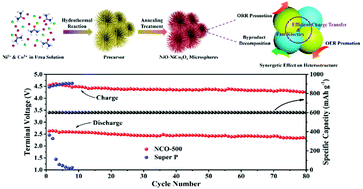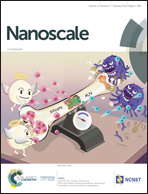Urchin-like NiO–NiCo2O4 heterostructure microsphere catalysts for enhanced rechargeable non-aqueous Li–O2 batteries†
Abstract
Urchin-like NiO–NiCo2O4 microspheres with heterostructures were successfully synthesized through a facile hydrothermal method, followed by thermal treatment. The unique structure of NiO–NiCo2O4 with the synergetic effect between NiCo2O4 and NiO, and the heterostructure favour the catalytic activity towards Li–O2 batteries. NiCo2O4 is helpful for boosting both the oxygen reduction reaction and oxygen evolution reaction for the Li–O2 batteries and NiO is likely to promote the decomposition of certain by-products. The special urchin-like morphology facilitates the continuous oxygen flow and accommodates Li2O2. Moreover, benefitting from the heterostructure, NiO–NiCo2O4 microspheres are able to promote the transport of Li ions and electrons to further improve battery performance. Li–O2 batteries utilizing a NiO–NiCo2O4 microsphere electrode show a much higher specific capacity and a lower overpotential than those with a Super P electrode. Moreover, they exhibit an enhanced cycling stability. The electrode can be continuously discharged and charged without obvious terminal voltage variation for 80 cycles, as the discharge capacity is restricted at 600 mA h g−1, suggesting that NiO–NiCo2O4 is a promising catalyst for Li–O2 batteries.

- This article is part of the themed collections: Nanoscale Most Popular Articles, National Nanotechnology Day and Nanoscale 10th Anniversary: Top Authors


 Please wait while we load your content...
Please wait while we load your content...